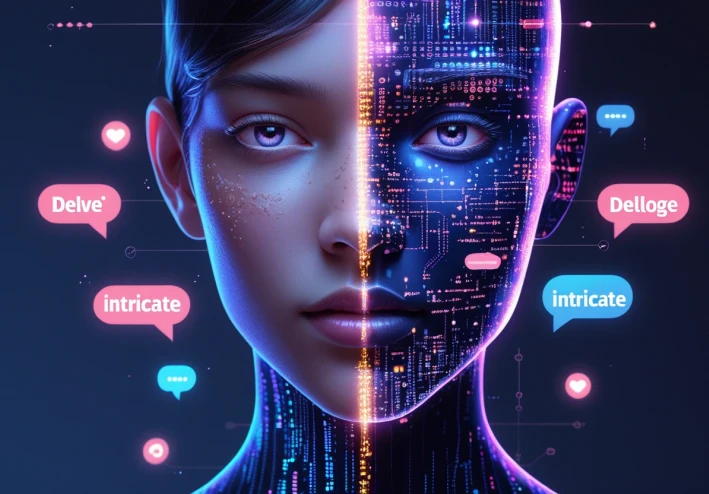
When Humans Begin Speaking Like AI: The Rise of LLM-Influenced Language
Introduction: AI’s Growing Grip on Human Speech
Artificial intelligence is no longer just a background tool—it’s a central force shaping the way humans interact. Millions of people now rely on conversational AI like ChatGPT, Claude, and Gemini for writing, learning, and even casual chats. What’s fascinating, and a little unsettling, is how these systems don’t just provide answers. They subtly reshape our vocabulary, syntax, and thought patterns.
This phenomenon, known as AI language influence, is pushing us into a new linguistic era. The signs are clear: from the words we write in emails to the way we speak in meetings, humans are slowly starting to talk like AI.
How AI Language Models Actually Process Language
To understand why this shift is happening, we first need to look at how large language models (LLMs) work. Unlike humans, AI doesn’t grasp meaning through lived experience. Instead, it processes text by transforming words into vector space embeddings—mathematical representations that capture semantic relationships.
For example, the word “king” might be represented as a set of numbers that relate closely to “queen,” “royal,” or “monarch.” By operating in this vector space, AI predicts the next most probable word in a sentence. This method is powerful for generating fluent responses, but it inevitably flattens human expression into statistical patterns.
The result? AI produces sentences that feel polished and logical, but often lack the depth, rhythm, or creativity of natural human speech.
The Rise of AI Vocabulary: Bias in Word Choice
If you’ve ever noticed that AI tends to “delve” into topics or describe things as “intricate,” you’re not imagining it. These systems overuse certain words. Why? Because reinforcement learning and data weighting make them favor vocabulary that aligns with training outcomes.
This creates what linguists call a lexical bias—a preference for a small set of elevated words that are repeated far more than in ordinary human conversation. Over time, users begin to adopt these words. A student might use “delve” in a paper without realizing they picked it up from ChatGPT. A professional might call a report “meticulous” simply because that’s how AI phrased it in a draft email.
This unconscious adoption of AI-preferred words is the foundation of the linguistic feedback loop.
The Linguistic Feedback Loop Explained
The relationship between humans and AI is not one-directional. Instead, it forms a cycle of mutual influence:
Humans feed AI training data.
Billions of pages of online text, academic papers, blogs, and conversations shape the way LLMs generate output.
AI generates biased patterns.
Because of its statistical learning, AI emphasizes certain words and structures over others.
Humans adopt these patterns.
Users copy-paste responses, mimic the polished style, or unconsciously absorb repeated vocabulary.
AI retrains on new human content.
The very content influenced by AI ends up reinforcing its own biases in future training.
This loop creates human-AI linguistic convergence—a process where our natural speech increasingly resembles AI’s artificial patterns. Each cycle makes it harder to distinguish whether an expression originated from a human or from an algorithm.
Evidence of AI’s Linguistic Imprint
The signs of this convergence are already everywhere:
Academic Writing: Researchers relying on AI tools are producing papers with higher frequencies of AI-favored words like “delve” and “comprehensive.” Submission databases show measurable increases in these terms over just two years.
Business Communication: Emails and corporate reports are beginning to sound more uniform, with employees adopting AI-polished phrasing such as “it is imperative,” “intricate details,” or “commendable efforts.”
Casual Conversation: Even in everyday speech, people are echoing AI expressions without realizing it. Phrases like “let’s unpack this” or “to provide clarity” are crossing from digital dialogue into spoken interactions.
Public Speaking: Analyses of online video transcripts show a steady rise in word choices associated with LLM outputs, suggesting that presenters who use AI assistance in drafting scripts are carrying that influence into live speech.
Why This Matters: Language Shapes Thought
The adoption of AI-influenced language isn’t just about vocabulary. Language has always been deeply tied to cognition. Psychologists call this the Sapir-Whorf hypothesis: the structure of language influences the way we think and perceive reality.
By narrowing expression into standardized, machine-driven patterns, AI risks limiting the range of our thoughts. If everyone begins to rely on the same polished phrases, creativity and diversity in communication may decline. Imagine a world where all speeches, essays, and stories sound “good” but eerily similar—a world where nuance is lost in favor of efficiency.
Even more concerning, AI doesn’t just bias words. It can also introduce social, cultural, or political biases hidden in its training data. Over time, these biases might subtly influence not only how we write, but also how we form opinions and beliefs.
Psychological Effects of Talking Like AI
The blending of human and AI speech patterns also raises psychological concerns:
Identity Shift: As people adopt AI-like expressions, their sense of personal voice may erode. Instead of sounding like themselves, they sound like the tool they use.
Perceived Authority: AI’s polished tone gives an impression of expertise. People who mimic this tone may come across as more professional, but also less authentic.
Cognitive Ease: Repeated exposure to AI vocabulary makes those words “feel right,” leading users to choose them more often without deeper thought.
Social Uniformity: Over time, conversations risk becoming predictable, reducing the richness of dialogue across different cultures and communities.
Balancing AI Assistance and Human Authenticity
The solution isn’t to avoid AI—it’s too deeply embedded in modern life. Instead, the goal should be conscious usage. Here are a few ways to protect linguistic diversity while benefiting from AI tools:
Edit AI outputs instead of copy-pasting. Add your own phrasing, idioms, or stylistic touches.
Stay aware of overused AI words. If you see words like “delve” or “intricate,” try swapping them for alternatives.
Preserve cultural expression. Use regional phrases, humor, or local idioms that AI is less likely to generate.
Limit dependence. For creative tasks like storytelling, journaling, or speeches, use AI only as a brainstorming partner—not the final author.
Promote linguistic diversity. Encourage schools and workplaces to value authentic voices over machine-polished uniformity.
The Future: Where Human-AI Language Might Go
Looking ahead, several scenarios could unfold:
Total Convergence: Human language and AI outputs become indistinguishable, leading to a world of hyper-standardized communication.
Hybrid Expression: People consciously blend AI’s clarity with personal creativity, resulting in new hybrid styles of writing and speaking.
Resistance Movements: Writers, educators, and artists may push back, emphasizing authenticity and unique expression as a counterbalance to machine influence.
Policy and Regulation: Governments and institutions may begin monitoring how AI affects communication, introducing guidelines to preserve linguistic diversity.
Whichever path emerges, one thing is clear: AI is no longer a silent assistant. It is an active participant in shaping the very fabric of human language.
Conclusion: Safeguarding the Human Voice
We are at a linguistic crossroads. On one side lies the efficiency and polish of AI-shaped communication. On the other lies the richness, unpredictability, and authenticity of human speech.
The rise of AI language influence and the linguistic feedback loop demonstrates just how powerful our tools have become. If we remain passive, we risk losing control over how we speak, write, and even think. But with awareness, creativity, and conscious choices, we can ensure that AI remains a tool that amplifies human voices—rather than replacing them.































